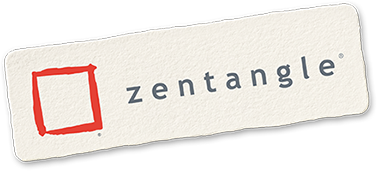Molly writes...
When Rick and Maria put together the first Zentangle kit, they wanted to include all the materials you needed to “begin” with the Zentangle Method, plus some extra supplies to keep your practice going for a while. Inside what has become our iconic green box was a stack of white tiles, black Micron pens, graphite pencils, a sharpener and tortillons. There was also a small simple booklet with some introductory information, a Zentangle legend card, an icosahedron die and a DVD with a short beginner lesson. The video lesson had no words to guide you, but rather some calming flute music. The visual cues were just enough to give you the information you needed to follow along. With this kit, you learned how to create a string with graphite, how to fill the spaces with basic tangles in ink, and, finally, how to shade the tangles with graphite. Between the video lesson and the introductory booklet, you could learn the basic outline of the 8 steps of the Zentangle Method, and then continue your practice on your own. Tanglers quickly grasped the concept. But, as you can guess, Zentangle enthusiasts were passionate and hungry for more.

The enthusiasts fed their hunger on their own, creating Zentangle art using the bits of instruction they could gather here and there. You might find a Zentangle artist tangling in a nook on their couch, standing at the counter in a kitchen, on the beach, in the car, in a waiting room, or on a break at work. From the beginning, the art form was designed to be portable, “low tech,” and accessible. The tools needed are simple and small enough to fit in a pocket or purse, so you really can tangle almost anywhere.
The community expanded quickly, and Rick and Maria did their best to support and nurture this growing group of artists. Most of the communications were through newsletters and a simple blog. They would share cute stories and new tangles or tips to give students fresh ideas and inspiration to inspire their practice. The method grew to have CZTs teaching worldwide, mostly in person, and they were inspiring students to start their own Zentangle journeys. Still, we kept things simple and pretty “low tech.” After all, we were teaching something that was innately “low tech.”
Simultaneously, though, the world was evolving fast, and technology was creeping into every space it could find. Staying “low tech” was becoming harder and harder. People from all over the world wanted access to more Zentangle. They wanted more information and more connection with a community and art form that they loved. To deliver that, we needed to rely more heavily on technology.
The next phase of sharing the Zentangle Method was born- sharing via digital platforms. CZTs started giving classes worldwide via the internet, and live and recorded videos became more available. It was still new, but we saw the future changing before our eyes, and we knew we had to join in. In 2018, we took our first attempt at a video lesson and launched our very first Project Pack video series. We thought we would only do one and see how it went. We had no idea what to expect. Turns out people liked it. We surprisingly enjoyed it too. We decided to do a few more, but continued to take our entry into e-learning slowly.
In 2020, we, like so many other businesses, were forced to rethink how we operated. We found ourselves in a time that none of us had ever experienced. It was clear that our community wanted more information and more connections and more tangling, and it was obvious that technology would have to play an important role in how we would do that. We were so grateful that we had the tools to do it. It was all at our fingertips… we just had to embrace it. That year, we produced and shared five Project Packs, and we held our first online CZT Seminar. It was something we thought we would never do. But as they say, never say never. It was an overwhelming success. Technology once again delivered. We learned that we could still “gather” and share the Zentangle Method authentically, and we could reach and certify people that we would never have been able to reach without the gift of technology. We were overwhelmed with stories of gratitude that we were making this an option. We continued to listen and respond to, and, as with many things, video instruction and e-learning soon became the norm for Zentangle too.
So, what is the point of my story here? Well, it starts with gratitude, of course. So much gratitude for all that technology has offered us. But I do find myself in a pickle, not just with Zentangle, but everything. Everything in our modern world somehow has a way of putting us back in front of a screen. Everything is digital, everything seems to need charging, or needs a password, or needs updating. We are overwhelmed and bombarded with technology even when we are doing the things that previously did not need technology. And even with Zentangle, which is as “low tech” and unplugged as it comes, we often find ourselves in front of a screen. It is a predicament that we are faced with. So, the question is… how do we honor the gift of technology but also know when it becomes too much? I guess that is where balance comes in.
I started to think more about this last year. It was a general observation I made, noticing how few things were left in the world that do not use any technology. At the same time, I wanted to hold space and celebrate the amazing successes that Zentangle has had in this digital world. If we want to find more balance, it is going to take effort for us to step away from all the technology and find those activities that don’t require charging, Wi-Fi, or passwords. We, as people, will have to push ourselves to rediscover these “low tech” activities and reintroduce them into our lives as general wellness practices.
As I pondered this, I realized that practicing Zentangle is, in its original form, a true unplugged activity… and that is something worth honoring in this always "on," digital age world! Last Fall, Zentangle HQ decided to do just that and began to work on a project that would bring us all back to the original intention of Zentangle. In October of 2024, we launched our Legends of Zentangle Series. The vision of this product was to create tools for Zentangle artists that inspire and challenge their practice without the need for screens.

So, while we continue to love video lessons and Zoom tangling sessions, we also want to remember that it is important to take our practices offline once and a while. It is a gift to be able to unplug and relax with just a couple of tools and some paper. This summer, we encourage you to get away from it all, even if just for an hour here or there. Pack up some tools and find a spot under a tree, on a park bench or a sandy beach, or an open seat at a coffee shop with a friend. Let your mind wander, listen to the sounds around you, and tangle. Take it all in for a bit. The rest of the world will be waiting for you once you are ready to plug back in.



Dione Greenberg CZT42 on
Keep the flow, George Weiss
George Weiss on
I did not purchase the Legends box since I had already purchased PP24 which is duplicated in that box. Is there a way to purchase the original L5 and the Lady Aura card?
I love this non tech way to develop a tile! Thank you!!!
Jane Roberts on
Online teaching can be hard to use on a trip in a coffee shop in the woods
I love Zentangle, cannot afford to be a CZT. I believe I would be a very good teacher especially to people who cannot pay like me!!!
Sherie Falink on
So, the funny story behind the Legend or the legend of the Legend is that L5 was actually the only one ever created. In the beginning Rick randomly chose the number 5 to mark the first one and when I ask him now, he cannot actually remember why he picked 5, but he does remember that it was intentional that they thought someday we would make more or others would make them on their own.
We did re-introduce the concept a few years back again in Project Pack 10 and those were in booklet form and were designed for the user to make their own legends as part of the lessons. These were labeled as Legends 1 through 11 including a review of the original L5 but these were different than the original cards.
Now back to the actual Legend Cards, here we are nearly 20 years later, finally making more. We will be digging more into this throughout the year so it is a fun one to follow. We started with the Legends of Zentangle Kit with the first installment of Lady Aura and then just released the Strings installment as the second with another coming out in June. Since we explored or used up the number references of L1 through L11 in the Project Pack we started with L20 as a fresh clean starting point for this new series as you can probably see noted on your Lady Aura cards.
Molly Hollibaugh on
Love this return to focus on the tactile practice and encouraging us to combine with offline nature experiences.
Long-haired Lori CZT20 on
So, I’ve been wondering about the numbers. First we got L5, and then in PP10 we got L1 to L11. The new legends cards start at L20. Are you planning something fun for L12 to L19? fingers crossed for a new project pack, with lots of new tangles
Petra Lassen on